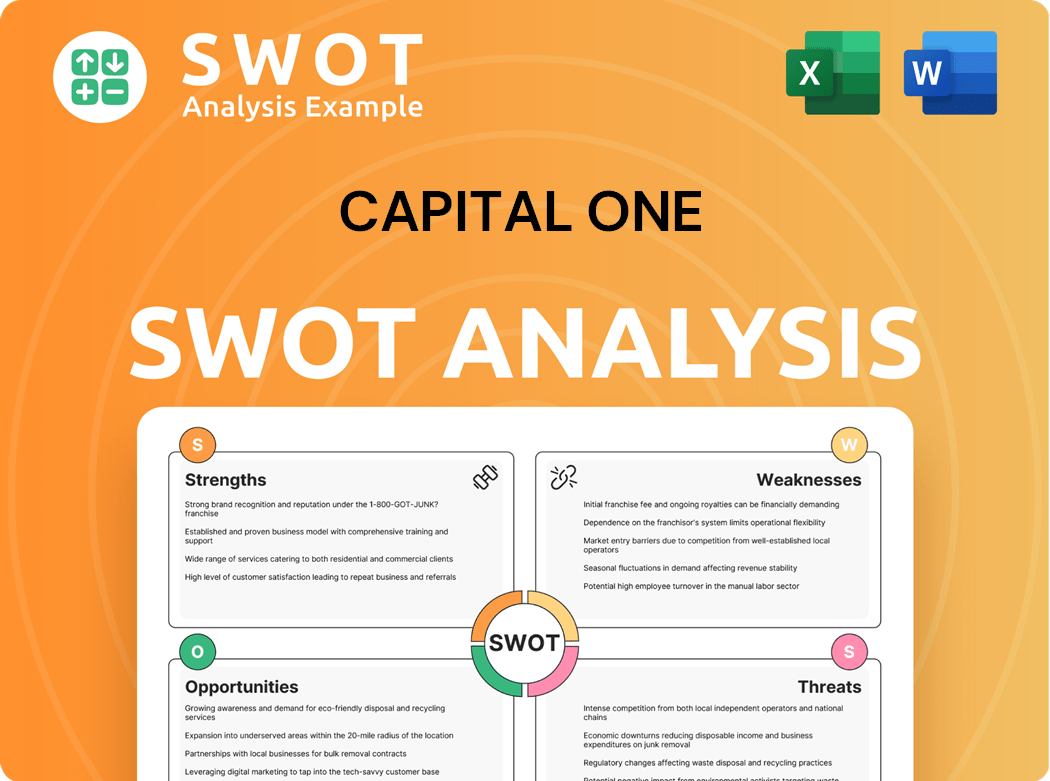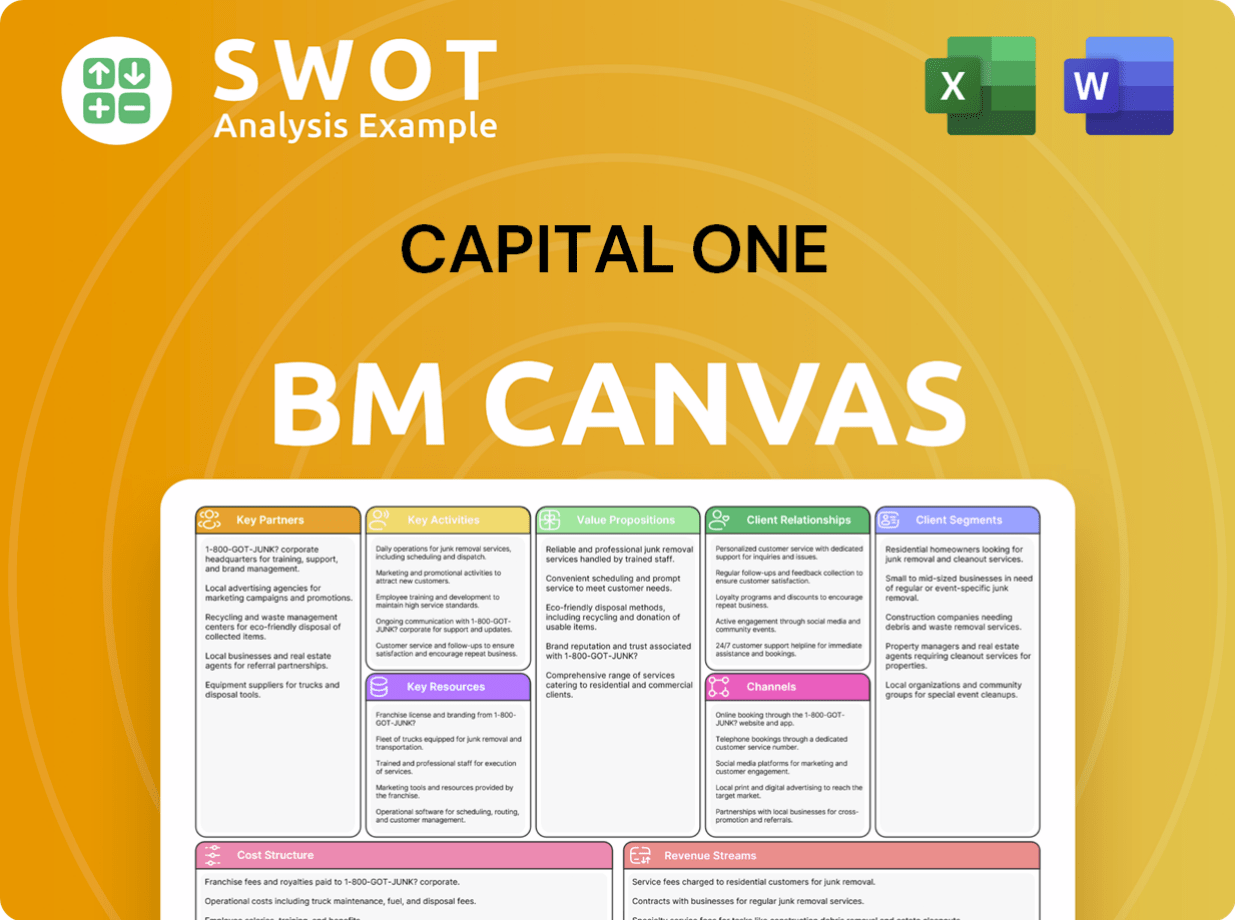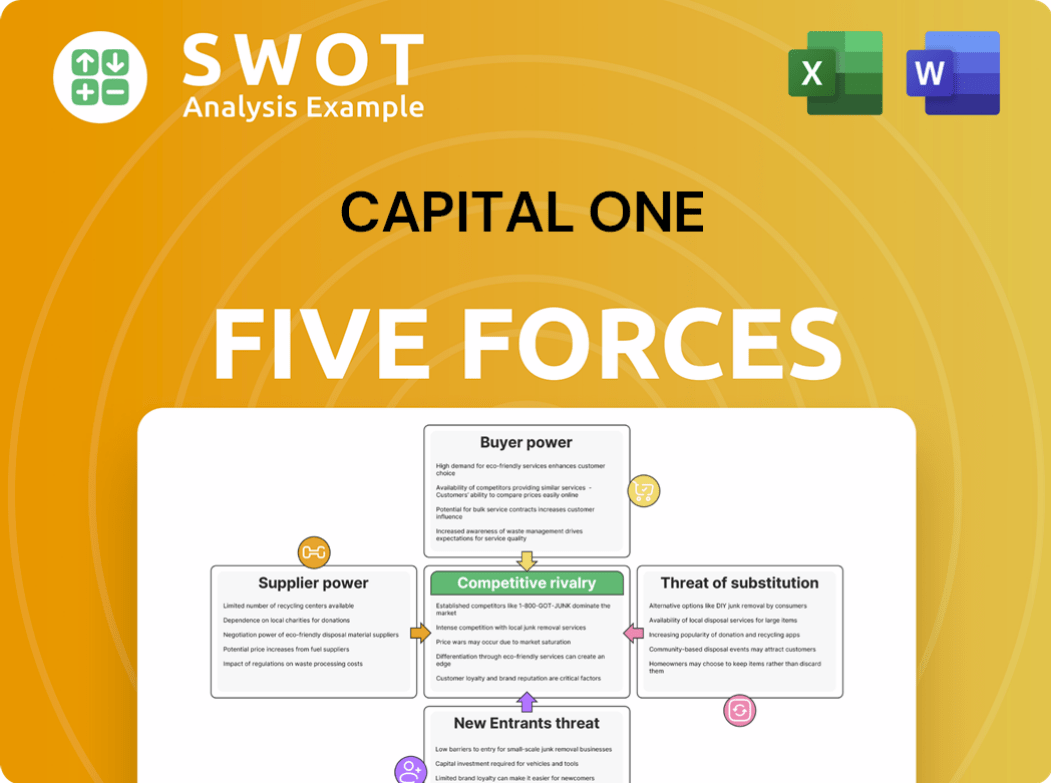Capital One Bundle
How Does Capital One Thrive in the Financial World?
Capital One, a powerhouse in the financial sector since 1994, has rapidly evolved, becoming a major player in credit cards, auto loans, and banking. As of late 2024, it's a top U.S. bank and a leading credit card issuer. The company's strategic use of technology has been a key driver of its success, providing innovative financial solutions to its customers.

This deep dive into Capital One SWOT Analysis explores the intricacies of its operations, from its diverse range of Capital One services to its ambitious acquisition strategy. Understanding the Capital One business model is essential for anyone looking to navigate the consumer finance landscape, especially with the pending Discover acquisition. We'll examine how Capital One generates revenue and its competitive advantages, offering a comprehensive view of its present and future.
What Are the Key Operations Driving Capital One’s Success?
The core operations of Capital One are centered around providing a diverse range of financial products and services. These offerings are tailored for consumers, small businesses, and commercial clients. The company’s operations are heavily reliant on technology and data, setting it apart from traditional banking models. This approach allows for greater efficiency and innovation in how Capital One serves its customers.
Capital One focuses on credit cards, auto loans, and various banking and savings accounts. It has made significant investments in technology, including artificial intelligence (AI) and machine learning, to enhance customer experience, streamline operations, and improve fraud detection. For instance, the virtual assistant, Eno, uses natural language processing to help customers manage their finances.
The value proposition of Capital One revolves around a customer-centric approach. It is focused on delivering personalized financial solutions and excellent customer service. Capital One has a more limited branch network, favoring online and mobile channels for customer acquisition and service. This digital-first strategy enables a national presence without the overhead of a large physical branch system.
Capital One's primary offerings include a variety of Capital One credit cards, auto loans, and banking services. They provide services to consumers, small businesses, and commercial clients. The company's diversified portfolio is designed to meet a wide array of financial needs.
Capital One leverages advanced technologies like AI and machine learning. These technologies enhance customer experience, streamline operations, and improve fraud detection. The use of digital tools is central to their operational efficiency and customer service delivery.
Capital One focuses on providing personalized financial solutions and exceptional customer service. They utilize online and mobile channels for customer acquisition and service. This approach allows them to reach a broad audience efficiently.
With a limited branch network, Capital One relies heavily on digital channels. This strategy allows them to achieve a national presence without the costs associated with traditional banking. The digital infrastructure supports a streamlined and efficient operational model.
Capital One's operational success is driven by a blend of product diversification, technological innovation, and customer focus. This model translates into enhanced customer benefits and market differentiation. The commitment to data and cloud-first infrastructure further boosts operational efficiency.
- Capital One financial products are designed to meet a wide range of customer needs.
- Advanced technologies like AI and machine learning are used to improve customer service and fraud detection.
- A digital-first strategy allows for efficient customer acquisition and service delivery.
- The company’s focus on data and cloud infrastructure supports innovation and operational efficiency.
Capital One SWOT Analysis
- Complete SWOT Breakdown
- Fully Customizable
- Editable in Excel & Word
- Professional Formatting
- Investor-Ready Format

How Does Capital One Make Money?
Understanding how Capital One generates revenue provides insight into its financial health and strategic direction. The company's revenue streams are diversified across several key segments, each contributing significantly to its overall financial performance. Analyzing these revenue streams and the monetization strategies employed offers a comprehensive view of Capital One's business model.
Capital One's primary revenue streams are segmented into Credit Card, Consumer Banking, and Commercial Banking. The Credit Card segment is the largest contributor, followed by Consumer Banking, and Commercial Banking. These segments are supported by various monetization strategies, including tiered pricing and cross-selling, aimed at maximizing profitability and customer engagement.
Capital One's financial success hinges on its ability to effectively manage and grow these diverse revenue streams. The company's strategic initiatives, such as the proposed acquisition of Discover Financial Services, are designed to enhance its competitive position and drive future growth. For more details on the Owners & Shareholders of Capital One, and their impact on the company's financial strategies.
The Credit Card segment is the largest revenue generator for Capital One. It includes domestic consumer and small business card lending, national closed-end installment lending, and international card lending. This segment is projected to contribute approximately 70% of the company's total revenues in fiscal year 2025, reaching an estimated $29 billion.
Consumer Banking offers a variety of services, including checking and savings accounts, auto loans, and mortgage lending. In Q1 2025, auto loans within Consumer Banking saw a 1% increase in period-end loans, reaching $77.7 billion. This segment contributes significantly to the company's overall revenue through interest and fees.
Commercial Banking provides financial services to businesses, including loans and treasury management. This segment focuses on serving the financial needs of corporate clients. Capital One’s Commercial Banking segment plays a crucial role in diversifying its revenue streams and supporting business growth.
In Q1 2025, Capital One reported a total net revenue of $10.0 billion, although this was a 2% decrease from the previous quarter. Net interest income reached $8.013 billion, marking a 7% year-over-year increase from Q1 2024. For the full year 2024, total net revenue increased 6% to $39.1 billion.
Capital One employs several monetization strategies to maximize revenue. These include tiered pricing for its credit card products, offering various benefits based on card type and customer profile. Cross-selling opportunities across banking and lending services also contribute to revenue growth.
The proposed acquisition of Discover Financial Services, valued at $35.3 billion, is a strategic move. This acquisition aims to integrate Discover's payment network, potentially shifting Capital One's debit transactions to Discover's network, which could enhance its competitive position. This move is expected to generate cost savings and expand its market footprint.
Capital One's financial performance is closely tied to its ability to manage its revenue streams effectively. The company focuses on strategic initiatives and market trends to maintain its competitive edge. Understanding these metrics and strategies is crucial for evaluating Capital One's financial health.
- Credit Card Revenue: Projected to reach $29 billion in 2025, representing approximately 70% of total revenue.
- Net Interest Income: Reached $8.013 billion in Q1 2025, up 7% year-over-year.
- Auto Loans: Period-end loans in Consumer Banking increased to $77.7 billion in Q1 2025.
- Acquisition Strategy: The proposed acquisition of Discover Financial Services for $35.3 billion aims to enhance its payment network and competitive position.
Capital One PESTLE Analysis
- Covers All 6 PESTLE Categories
- No Research Needed – Save Hours of Work
- Built by Experts, Trusted by Consultants
- Instant Download, Ready to Use
- 100% Editable, Fully Customizable

Which Strategic Decisions Have Shaped Capital One’s Business Model?
The journey of Capital One has been marked by significant milestones and strategic shifts that have shaped its operations and financial performance. A crucial turning point was its early adoption of an information-based strategy, using data and statistical analysis to drive decisions and broaden access to credit cards. This approach helped the company grow from a credit card operator to a top-ten bank. The company has demonstrated a solid understanding of the financial landscape and a commitment to innovation within the financial services sector.
A notable product launch was the Venture X travel rewards credit card in November 2021, targeting premium customers. However, the company has also faced operational challenges, including the termination of its Walmart private label and co-branded credit card program in April 2024 due to customer service failures. Capital One retained ownership of the existing portfolio and is converting eligible customers to its branded card products. These moves reflect the company's adaptability and responsiveness to market dynamics.
The most significant strategic move in recent history is the proposed $35.3 billion acquisition of Discover Financial Services, announced in February 2024. If approved, this merger would make Capital One the largest credit card issuer in the U.S. and significantly challenge the market dominance of Visa and Mastercard. This move underscores Capital One's ambition to expand its market share and capabilities within the financial industry. For further insights into Capital One's strategic direction, consider reading Growth Strategy of Capital One.
Early adoption of data-driven strategies. Launch of the Venture X travel rewards credit card in November 2021. Termination of the Walmart private label credit card program in April 2024.
Proposed $35.3 billion acquisition of Discover Financial Services, announced in February 2024. Conversion of Walmart cardholders to branded products. Continuous investment in technology and customer-centricity.
Strong brand recognition and technological leadership. Diversified product portfolio including Capital One credit cards and Capital One banking services. Cost advantage through a limited branch network and online banking.
The proposed acquisition of Discover Financial Services is valued at $35.3 billion. Capital One continually adapts to new trends and competitive threats by focusing on customer-centricity, leveraging data-driven insights, and pursuing strategic acquisitions to expand its reach and capabilities. The company has a strong focus on Capital One financial products.
Capital One's competitive advantages include strong brand recognition, technological leadership, and a diversified product portfolio. Its heavy investment in technology, particularly in AI and machine learning, has led to innovative products and services, enhancing customer experience and operational efficiency.
- Strong brand recognition and customer loyalty.
- Technological innovation, especially in AI and machine learning.
- Diversified product portfolio, including Capital One services.
- Cost advantages through online banking and a limited branch network.
Capital One Business Model Canvas
- Complete 9-Block Business Model Canvas
- Effortlessly Communicate Your Business Strategy
- Investor-Ready BMC Format
- 100% Editable and Customizable
- Clear and Structured Layout

How Is Capital One Positioning Itself for Continued Success?
As of September 30, 2024, Capital One holds a strong position in the financial services industry. It ranks as the ninth-largest bank in the United States by total assets and is a major player in the credit card market, particularly with its Capital One credit cards. The company's strategic moves and financial performance are closely watched by investors and competitors alike.
The company's future is also significantly influenced by its planned acquisition of Discover Financial Services. This move, if approved, would make Capital One the largest U.S. credit card lender, reshaping the competitive landscape and potentially impacting its Capital One services offerings. The company faces various risks, including economic fluctuations and regulatory changes.
Capital One is a major player in the U.S. banking and credit card industries. It is the third-largest issuer of Visa and Mastercard credit cards. The company's primary competitors include JPMorgan Chase, Bank of America, and American Express.
Key risks include regulatory scrutiny, especially related to the Discover acquisition. Economic downturns, such as higher interest rates, could increase credit costs. In Q1 2025, the provision for credit losses was $2.4 billion. Competition from fintech companies is also a factor.
Capital One is focused on leveraging technology, particularly AI and machine learning, to enhance customer experiences. The Discover acquisition is central to its strategy, aiming to create a significant consumer banking and global payments platform. The company is committed to growth in its credit card and consumer banking sectors.
Capital One's Common Equity Tier 1 capital ratio was 13.6% as of March 31, 2025, indicating a strong capital position. The company's strategic initiatives are aimed at sustained growth and operational efficiency. The company's performance and future are also affected by the overall economic climate. To understand who the company targets, read about the Target Market of Capital One.
Capital One Porter's Five Forces Analysis
- Covers All 5 Competitive Forces in Detail
- Structured for Consultants, Students, and Founders
- 100% Editable in Microsoft Word & Excel
- Instant Digital Download – Use Immediately
- Compatible with Mac & PC – Fully Unlocked

Related Blogs
- What are Mission Vision & Core Values of Capital One Company?
- What is Competitive Landscape of Capital One Company?
- What is Growth Strategy and Future Prospects of Capital One Company?
- What is Sales and Marketing Strategy of Capital One Company?
- What is Brief History of Capital One Company?
- Who Owns Capital One Company?
- What is Customer Demographics and Target Market of Capital One Company?
Disclaimer
All information, articles, and product details provided on this website are for general informational and educational purposes only. We do not claim any ownership over, nor do we intend to infringe upon, any trademarks, copyrights, logos, brand names, or other intellectual property mentioned or depicted on this site. Such intellectual property remains the property of its respective owners, and any references here are made solely for identification or informational purposes, without implying any affiliation, endorsement, or partnership.
We make no representations or warranties, express or implied, regarding the accuracy, completeness, or suitability of any content or products presented. Nothing on this website should be construed as legal, tax, investment, financial, medical, or other professional advice. In addition, no part of this site—including articles or product references—constitutes a solicitation, recommendation, endorsement, advertisement, or offer to buy or sell any securities, franchises, or other financial instruments, particularly in jurisdictions where such activity would be unlawful.
All content is of a general nature and may not address the specific circumstances of any individual or entity. It is not a substitute for professional advice or services. Any actions you take based on the information provided here are strictly at your own risk. You accept full responsibility for any decisions or outcomes arising from your use of this website and agree to release us from any liability in connection with your use of, or reliance upon, the content or products found herein.